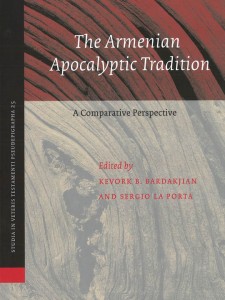Staff Report

At the end of 2014, Dr. Sergio La Porta published a collection of essays on The Armenian Apocalyptic Tradition. Co-edited with Prof. Kevork Bardakjian of the University of Michigan, Ann Arbor, the volume, published in the Studia in Veteris Testamenti Pseudepigrapha series of Brill publishers, contains some 30 articles by a diverse body of scholars from the United States, Armenia, Canada, Israel, and Europe. The articles cover apocalyptic visions and texts from Armenia’s pre-Christian past to the fifteenth century in a comparative context.
The volume breaks new and significant ground in the understanding of eschatological expectations and apocalyptic fears in Armenian literature.
The volume contains two contributions by Dr. La Porta himself: one on the vision of St. Gregory the Illuminator; the second, on a counsel by the monastic teacher Vardan Aygekc‘i completed in 1212 that addresses the birth of the Antichrist and the end of the world.
Among Dr. La Porta’s publications this past year was an article on intellectual exchange and competition between Armenian apostolic monastic institutions and Latin missionaries in the fourteenth centuries. It examined the missionary efforts of Franciscan and Dominican friars and suggested that Latin teachings appealed to Armenians because of their Aristotelian focus. Engagement with these teachings and the conversion of Armenian monks to Latin Christianity, led to both a harsh reaction on the part of Armenian apostolic monastic institutions, as well as a reform of monastic education. On the one hand, an independent inquisition of Armenian monasteries was spearheaded by the monastic leaders of the region of Siwnik‘ in which those who had accepted Latin Christian doctrines were brutally treated and even executed.
On the other hand, Latin teachings, methods of organization, and structure of curricula were adapted to the Armenian intellectual tradition. The result was a revitalization of biblical and theological speculation in these monastic schools. The article was published in volume 21 of the journal, Medieval Encounters.
 Hye Sharzhoom Armenian Action
Hye Sharzhoom Armenian Action